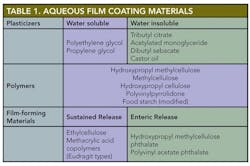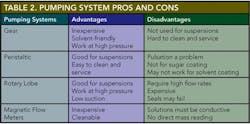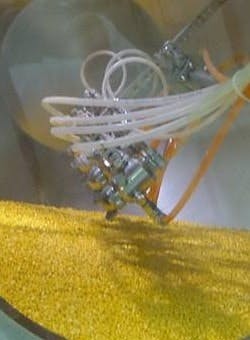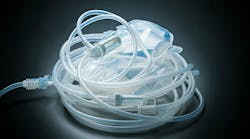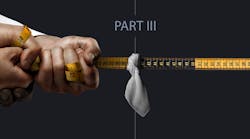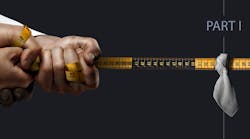Good gun placement includes a fixed gun-to-bed distance and a consistent gun-to-gun setting.
|
Operators should first look straight down the boom to check that the guns have not become misaligned, or cocked, which can easily occur as material is moved into and out of the pan. Cocking can also result when mechanical equipment is adjusted, when fittings loosen or when equipment is abused. The direction in which the guns are cocked is important:
- Side to side will generally result in overwetting.
- Up or down will cause solution to stick to the pans.
Gun-to-bed distanceThe gun-to-bed distance is fixed, never a range, and the proper value is usually included in the product specification. Usually, for aqueous coatings, settings are 8 or 10 in. from the bed, depending on the spray rate used.However, the gun-to-gun distance, which is usually assumed to be fixed, may change during maintenance or gun change-out. Therefore, this dimension must be verified prior to each new coating campaign. This value isnt usually stated as a specification or set point on the worksheet, but the setting is typically 5.5 or 6.0 in. from gun tip to gun tip between guns.
Distance between gun and side of the panThis setting is widely understood but not always recognized as a variable that should be checked. In order to optimize the distance between the gun and the side of the pan, the operator should measure the tip of the last gun on either side of the boom, either to the front side of the pan or to the back of the drum. If this distance is set incorrectly, there will be solution on the window, solution on the side of the pan, or on both the side and the back of the pan.The setting can be checked with placebo tablets or a large sheet of paper before the gun is fixed, and should be checked regularly thereafter. A flashlight helps in looking for problems.
Gun-to-bed heightTablet beds may differ based on pan charge, batch yields and the size and shape of the tablet. Guns should be set at the bottom of the waterfall in the upper third of the bed. This setting should be rechecked at the start of each campaign, or any time pan charge changes.
CalibrationCalibration is also critical. Variation in solution rates between guns is a common problem. This value should not vary by more than +/- 10 ml between guns. If the variation exceeds the recommended value, the needle stroke can be adjusted from the back of the gun.
Atomizing and pattern airBoth atomizing and pattern air levels must be carefully set. Too much pattern air flattens the cone and can result in overspray, wetting and picking. Too little concentrates the cone in too small an area within the tablet bed, resulting in tablet erosion or picking.Pattern air shapes the suspension cone, so the more air, the flatter the cone. In some systems, pattern air is fixed and in others it is variable and set by the operator.
Pan pressureExcessive pressure causes unusual defects in product that are usually wrongly attributed to other causes. This value should never be positive. Typically, it should be set between -0.1 in. and -0.50 in. (H
2O). It should never exceed -1.0 in. H
2O. Pressure can be seriously reduced when the seals used to maintain this pressure weaken or break. Any damaged seals should be replaced immediately.
Pan speedThere is no single setting for this, although there are rules of thumb based on tablet size, shape and load (
Pharmaceutical Manufacturing, October 2004, p. 43). Two basic pan speeds should be set for each product: an initial speed to achieve a basic covering, then a steady state speed to optimize the finished tablet appearance.Anti-slide bars and baffles can be used to center the tablet bed in front of the outlet air plenum. These are not used for mixing, and should be mandatory in any installation. Baffles, however, do serve as a mixing device, and are usually supplied as a standard feature regardless of the vendor one selects.
Spray rateThis value should usually be set between 80 and 150 ml/min. for each gun. For installations where the gun-to-bed distance is 8 in., 80 ml/min. per gun would be the recommended level. For installations with a gun-to-bed distance of 10 in., the recommended distance would be 120 ml/min. per gun.
Inlet and outlet air temperatureOperators should key on an outlet air temperature target, typically between 45° and 55˚ C, and let the inlet air vary within a given range. It is critical to remember that inlet air temperature is a set point, while outlet air temperature is a function, based on the following non-mathematical equation:
Inlet Air (in ft.3/min., or cfm) + T Inlet Air +
Spray Rate + Atomizing Air = T Outlet AirThus, monitoring outlet air temperature helps determine whether other factors may have changed or shifted.
Total drying capacity, or total air volumeTotal air volume, in ft.
3/min., determines coating efficiency. Although the coating process can usually tolerate some variations in total air volume, optimizing the total air volume is urgent for heat- or moisture-sensitive products.These two classifications of tablets require special handling during the aqueous coating process. Heat-sensitive products may be safely coated using a lower inlet air temperature and a corresponding slower spray rate. Moisture-sensitive products may be safely processed using a higher inlet air temperature, a larger quantity of inlet air volume and a slower spray rate.
Particle adhesion to the gun assemblyAny adhesions must be quickly and completely removed. To remove, it is best to leave the atomizing air on, stop spraying, brush residue off the gun assembly and then resume the spraying cycle.By paying close attention to operating parameters and adhering to fundamental practices, coating professionals can greatly improve the quality of their work and drug products.
About the AuthorFred Rowley holds a B.S. degree in Biochemistry from the University of Santo Thomas. He is currently Guest Speaker of Solid Dosage Training, Inc. He is also director of manufacturing technical support for a leading pharmaceutical firm. He has held senior manufacturing and technical positions at Stayner Pharmaceuticals, Shaklee Corp., Syntex Laboratories, Alza Corp. and Weider Nutrition International.
Troubleshooting Aqueous Coating
To be successful, coating operators must know the enemy. The following is a list of the 10 least wanted coating defects, and their causes.
- Rough or orange peel surfaces are caused when the tablet membrane is spray dried. Usually this occurs because insufficient coating vehicle has been added, because the ratio of coating volume to inlet temperature is too high, or atomization air level is too high.
- Picking results when tablets are wet. Usually this problem can be traced to too high a spray rate, insufficient atomizing air or too low a pan speed. It can also occur when the spray guns are too close to each other.
- Film cracking happens when the wrong, or insufficient, plasticizer is used, when the solution is too concentrated or there isnt enough atomizing air.
- Film chipping results from too high a pan speed, too low a spray rate, or both conditions together, sometimes coupled with sharp tablet edges, indicating problems with tooling design.
- Logo bridging occurs when letters and numbers on the tablet are filled in with dried suspension. It is usually caused by high spray rate coupled with high air volume, inadequate atomizing air, and poor tooling design.
- Film peeling occurs while tablets are actually baking in the coating pan and coating ruptures. Typical culprits are a very high spray rate, low cfm (cubic feet per min.), tacky coating material or lack of adhesion due to excessive tablet hardness, measured in kiloponds (Kp).
- Twinning results from high spray rate, inadequate drying capacity, too thick a belly band on the tablet itselfa tooling design rather than a coating issue, or too long a tablet.
- Logo erosion occurs before the coating can stick to the surface. Its usually the result of too slow a spray rate, too fast a pan speed or both conditions used together. Tablets that are too soft can also contribute to the problem.
- Stability issues result from physical changes in tablet appearance, and are usually detected as off-color or off-odor. The coating suspension may have been contaminated by microbes, or affected by moisture or heat, or there may be incompatibility between film and tablet, the excipient and API or both factors combined.
|
Are Your Operators in Focus?
You know youre in trouble if you hear any of the following in the coating room:
- So what if the gun drips a bit?
- A little coating material at the back of the pan is normal.
- Needles bend a little. It doesnt matter.
- Pan pressure is the pressure of tablets pressing up against the drum. The more the better.
|

